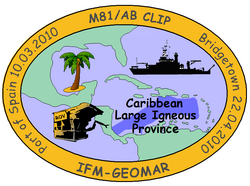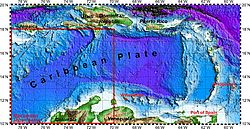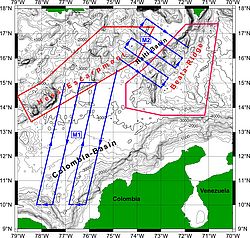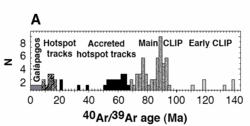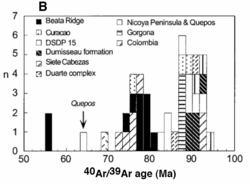In March/April 2010, the research cruise M81/2AB (Port of Spain – Willemstad/Curaçao – Barbados) was conducted in the framework of the research project CLIP (Caribbean Large Igneous Province). This study, employing the research vessel METEOR, has the objective to gain new insights into the – as yet debated - formation and geodynamic development of the Caribbean Large Igneous Province and the Caribbean Plate (Fig. 1, 2).
Large Igneous Provinces (LIP) are gigantic lava plateaus representing the volumetrically largest volcanic events on Earth. They are often situated at the beginning of volcanic island chains (hotspot traces) and thus it is assumed that they originate during the initial phase of a mantle plume, i.e. after the “initial plume head” has reached the base of the lithosphere. The CLIP consists of deformed oceanic crust as well as of flood basalts accreted to the northwestern continental margin of Central- and South America. Initially, age dating indicated a formation of the CLIP largely before 89±6 Ma. This isochronic occurrence of volcanism of identical geochemical composition throughout the Caribbean Plate has traditionally been ascribed to the initial plume head of the Galápagos hotspot. However, new samples show a high geochemical variability and new radiometric and paleontological ages indicate both older and younger dates (Fig. 3).
This project will investigate now, whether the main part of the CLIP can be explained by a single event about 89 Ma ago, or alternatively whether the CLIP represents an accumulation of volcanic structures which span more than 70 Ma and were assembled via subduction processes. To achieve these goals hard rock sampling as well as multibeam and parasound profiling will be conducted. Rock sampling will be complementary, i.e. during leg M81/2A the remotely operated vehicle ROV Kiel 6000 will be used to sample transects stratigraphically controlled, while for leg M81/2B sampling with chain bag dredges in formerly un-sampled areas is scheduled. Subsequently, morphological, volcanological, petrological, geochemical and geochronological studies are planned.
Closely related is the question about the origin of the Caribbean Plate. For the development of the region, which has a very complex structural history, two models have been proposed:
- „Pacific Model“: late Mesozoic origin of the Caribbean oceanic crust above the Galápagos- and/or the Sala y Gomez hotspot in the Pacific, and subsequent plate tectonic drift into today’s position.
- „Inter-American model“: An origin west of today’s position but between the Americas.
According to the two model scenarios, the strike directions of seafloor spreading anomalies in the pre-existing crust on which the CLIP was formed, have different orientations (at least, during the formation of the CLIP). A crucial test for the different models will be the magnetic profiling performed during cruise M81/2AB. Thus, by identifying the orientation of the magnetic lineations, we hope to give vital contributions to the question about the origin of the CLIP.
All in all, from the new data and analyses of this multidisciplinary research project we expect important contributions to the understanding of intraplate volcanism and the development of oceanic Large Igneous Provinces.
Origin and development of the CLIP and other oceanic LIP has been investigated previously by our research group, for instance within the scope of Panamá Terranes, Guatemala Forearc, SO168 Zealandia, SO193 Manihiki.
Principle investigators: Prof. Kaj Hoernle (Project Coordinator) and Dr. Folkmar Hauff
Scientific employee and organisation of cruise M81: Dr. Reinhard Werner (GEOMAR)
Coordination assistance: Dr. Doris Maicher (GEOMAR)
Funding source: DFG
Cooperation: Dr. Udo Barckhausen, Bundesanstalt für Geowissenschaften und Rohstoffe (BGR), Stilleweg 2, D-30655 Hannover (http://www.bgr.bund.de).
Prof. Martin Meschede, PD Dr. Heiko Hüneke, Institut für Geographie und Geologie, Ernst Moritz Arndt Universität Greifswald, Friedrich-Ludwig-Jahn-Str. 17A, D-17487 Greifswald (http://www.uni-greifswald.de/).
Prof. Robert Duncan, College of Oceanic and Atmospheric Sciences, Oregon State University, Corvallis, Oregon 97331, U.S.A. (http://oregonstate.edu).
Prof. Peter Baumgartner, Université Laussane, Institut de minéralogie et géochimie, Quartier UNIL-Dorigny, Bâtiment Anthropole, 1015 Lausanne, Switzerland (http://www.unil.ch/index.html).


